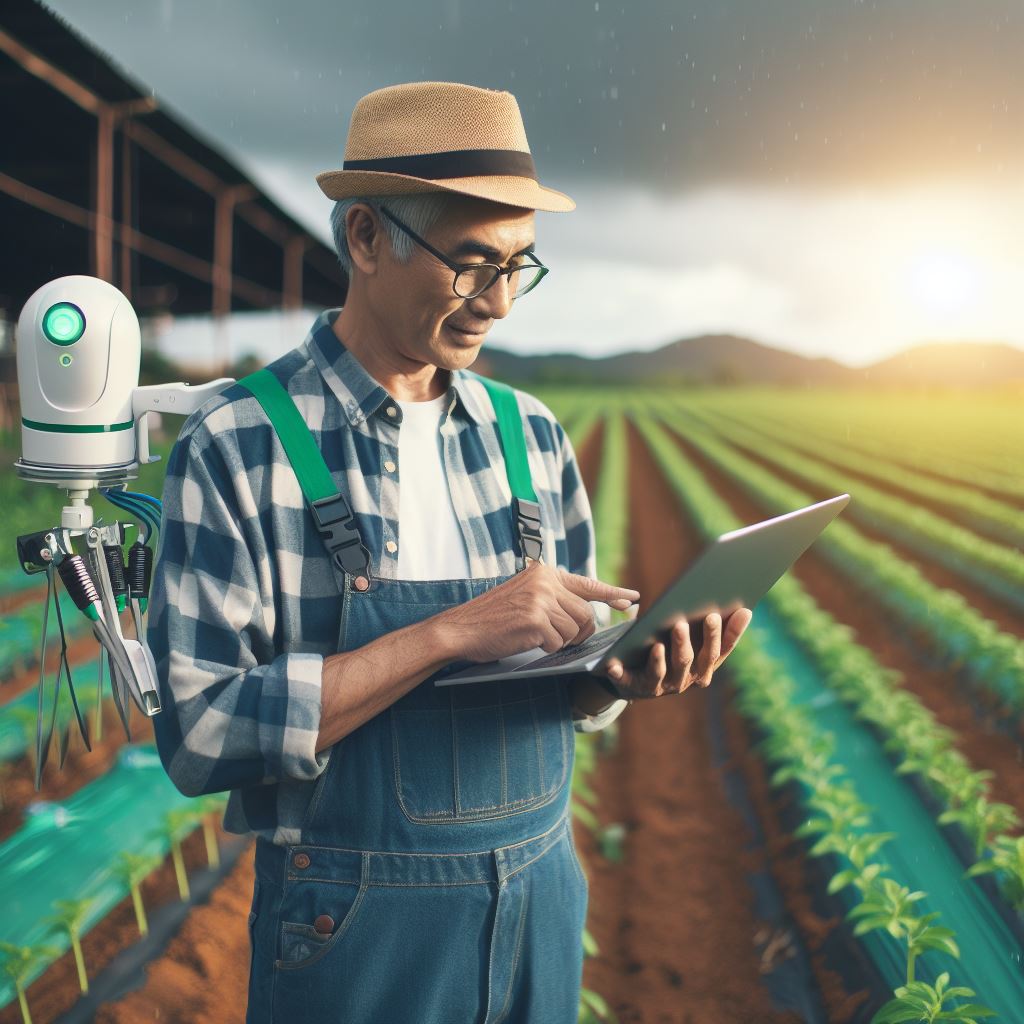Crop Monitoring AI: Precision Farming Tech
Last Updated on January 23, 2024
Introduction
Crop monitoring precision farming AI tech is a groundbreaking technology that has revolutionized agricultural practices.
This blog post aims to provide an overview of this groundbreaking technology and its significance in precision farming.
Definition and Purpose of Crop Monitoring AI
Crop monitoring AI refers to the use of artificial intelligence in the monitoring and management of crops.
Its purpose is to enhance agricultural practices by providing real-time insights and predictive analytics.
Importance of Precision Farming Technology in Agriculture
Precision farming technology, facilitated by crop monitoring AI, plays a crucial role in modern agriculture.
It optimizes resource utilization, maximizes crop yield, minimizes environmental impact, and improves overall efficiency.
Precision farming technology helps farmers make data-driven decisions by providing accurate and timely information about soil conditions, irrigation needs, pest infestations, and crop health.
By collecting data from various sources including satellite imagery, drones, and ground sensors, crop monitoring AI enables farmers to monitor crops remotely and identify potential issues before they escalate.
Moreover, it facilitates the implementation of site-specific farming techniques, allowing farmers to tailor their strategies to the unique needs of different areas within a field.
This technology also aids in the prevention and control of diseases, as AI algorithms can detect early warning signs and recommend appropriate measures for treatment.
Furthermore, by reducing the use of chemical inputs and optimizing the application of fertilizers and pesticides, precision farming technology promotes sustainable agriculture practices.
Basically, crop monitoring AI and precision farming technology are transforming the agricultural landscape by revolutionizing how crops are monitored and managed.
By harnessing the power of AI, farmers can make informed decisions and achieve higher productivity while minimizing environmental impact.
How to crop monitoring AI works
The use of artificial intelligence in crop monitoring
- Artificial intelligence (AI) is revolutionizing the agricultural industry by improving crop monitoring processes.
- AI systems utilize algorithms and machine learning techniques to analyze vast amounts of data.
- These AI systems can make accurate observations and predictions about crop growth and health.
- By using AI, farmers can gain valuable insights into their crops and make informed decisions.
- AI helps to reduce manual labor and improve overall efficiency in crop monitoring.
Overview of data collection methods used by AI systems
- Crop monitoring AI systems collect data from various sources, including satellites, drones, and sensors.
- Satellite imagery provides high-resolution images of crops, helping identify growth patterns and detect anomalies.
- Drones equipped with advanced sensors can capture detailed information about crops in real-time.
- Ground-based sensors monitor soil moisture, temperature, and other environmental factors critical for crop health.
Role of machine learning algorithms for analysis and prediction
- Machine learning algorithms play a pivotal role in analyzing the data collected by AI systems.
- These algorithms can identify patterns, correlations, and anomalies within the crop data.
- By leveraging historical data, machine learning algorithms can predict crop growth, yield, and disease outbreaks.
- AI systems combine data analysis with expert knowledge to provide actionable recommendations to farmers.
- Through continuous learning, AI systems improve their accuracy over time and adapt to changing environmental conditions.
Crop monitoring AI, powered by artificial intelligence, is transforming precision farming.
The use of AI in crop monitoring allows for efficient data collection from various sources, such as satellites, drones, and sensors.
Machine learning algorithms play a crucial role in analyzing this data and making accurate predictions about crop growth and health.
By harnessing the power of AI, farmers can make informed decisions, optimize crop management practices, and improve overall agricultural productivity.
The future of farming lies in the hands of AI, as it enables sustainable and resource-efficient agriculture.
Read: Revolutionizing Farms: Drones in Crop Monitoring
Benefits of using crop monitoring AI
Increased efficiency and productivity in agricultural operations
- Crop monitoring AI utilizes advanced algorithms to efficiently detect crop diseases and pests.
- By identifying the exact areas affected, farmers can take immediate action and prevent further damage.
- This real-time monitoring helps in reducing crop losses and increasing overall productivity.
- Farmers can also automate various farming tasks, saving time and improving efficiency.
- By using AI-powered drones or robots, farmers can perform tasks such as seeding, spraying, and harvesting with precision.
Improved resource management, such as water and fertilizers
- Crop monitoring AI can analyze soil moisture levels and predict irrigation requirements.
- By providing accurate data, it helps farmers optimize water usage and conserve this precious resource.
- This technology can also track nutrient levels in the soil and determine the need for fertilizers.
- By applying fertilizers only where necessary, farmers can minimize waste and reduce environmental impact.
- AI-powered sensors can monitor the growth and health of crops, allowing farmers to adjust nutrient and water levels accordingly.
Enhanced decision-making and optimized crop yield through real-time monitoring
- With crop monitoring AI, farmers can access real-time data about their fields without physically inspecting them.
- They can monitor crop growth, identify potential issues, and make informed decisions based on accurate information.
- By analyzing historical data, AI algorithms can provide insights into the best planting, harvesting, and crop rotation practices.
- This optimization can lead to higher crop yields, improved quality, and increased profitability.
- Farmers can also detect early signs of disease or climate-related problems and take preventive measures.
Benefits of Crop Monitoring AI
Increased efficiency and productivity
Crop monitoring AI brings numerous benefits, including increased efficiency and productivity in agricultural operations.
By utilizing advanced algorithms, AI can detect crop diseases and pests, allowing farmers to take immediate action.
This real-time monitoring helps reduce crop losses and automate various farming tasks, improving overall efficiency.
Improves resource management
Additionally, crop monitoring AI improves resource management, particularly in areas such as water and fertilizers.
By analyzing soil moisture levels and predicting irrigation requirements, farmers can optimize water usage and conserve this precious resource.
AI also tracks nutrient levels in the soil, allowing farmers to apply fertilizers only where necessary, minimizing waste and reducing environmental impact.
Enhances decision-making and optimizes crop yield
Moreover, crop monitoring AI enhances decision-making and optimizes crop yield through real-time monitoring.
It provides farmers with access to accurate data about their fields without physical inspection.
They can monitor crop growth, identify potential issues, and make informed decisions based on real-time information.
By analyzing historical data, AI algorithms provide valuable insights into the best planting, harvesting, and crop rotation practices, leading to higher crop yields and improved profitability.
Enables early detection of disease or climate-related problems
Furthermore, crop monitoring AI enables early detection of disease or climate-related problems, allowing farmers to take preventive measures and minimize crop damage.
This technology revolutionizes the way farmers manage their crops, ensuring better outcomes and increased sustainability.
Essentially, the benefits of using crop monitoring AI in precision farming are undeniable.
It increases efficiency and productivity, improves resource management, enhances decision-making, and optimizes crop yield.
By implementing AI-powered technologies, farmers can achieve sustainable and profitable agricultural operations.
Read: Crop Monitoring: New Tech Insights
Application examples of crop monitoring AI
Monitoring plant health and pest detection
- Crop monitoring AI enables real-time analysis of plant health, detecting diseases or pest infestations.
- By analyzing data obtained through sensors and cameras, AI systems can identify stress factors in plants.
- Early detection of diseases or pests allows farmers to take immediate action, minimizing crop losses.
- AI algorithms can alert farmers to specific areas requiring attention, improving efficiency and reducing labor costs.
- With the help of AI, farmers can make informed decisions on pest control measures and disease management.
Yield estimation and prediction
- Crop monitoring AI utilizes machine learning algorithms to estimate crop yield accurately.
- By analyzing data such as weather patterns, soil conditions, and plant growth, AI can predict yield.
- Accurate yield estimation enables farmers to plan their resources effectively, optimizing production and profitability.
- AI systems can provide real-time yield predictions, allowing farmers to make timely decisions on harvesting and storage.
- Yield prediction helps farmers meet market demand, reduce wastage, and plan for better crop distribution.
Weed control and differentiation
- AI-powered crop monitoring can differentiate between weed species and crop plants, enabling targeted control measures.
- By analyzing images and data, AI algorithms can detect and classify different weed species accurately.
- Farmers can use this information to apply selective herbicides, minimizing the impact on crops and the environment.
- AI systems can create weed density maps, assisting farmers in identifying areas requiring immediate attention.
- Efficient weed control through AI technology reduces manual labor, time, and overall costs for farmers.
Nutrient deficiency detection and management
- Crop monitoring AI can detect nutrient deficiencies in plants, allowing farmers to take appropriate action.
- Through the analysis of plant tissue samples and sensor data, AI algorithms can identify nutrient deficiencies.
- Farmers can adjust fertilizer application based on AI recommendations, optimizing nutrient uptake and plant health.
- AI technology enables precise nutrient management, reducing the risk of over-application and environmental pollution.
- Timely detection and management of nutrient deficiencies through AI lead to improved crop growth and overall productivity.
In general, crop monitoring AI technology offers various application examples for precision farming.
It enables monitoring of plant health and pest detection, accurate yield estimation, weed control, and nutrient deficiency management.
By leveraging AI algorithms and data analysis, farmers can make informed decisions and optimize their farming practices.
Integrated crop monitoring AI systems have the potential to revolutionize agriculture, improving productivity, sustainability, and profitability for farmers.
Read: Smart Farming: IoT in Crop Management

Challenges and limitations of crop monitoring AI
Data accuracy and integration challenges
- Crop monitoring AI heavily relies on accurate and reliable data for decision-making.
- Gathering high-quality data can be a challenging and time-consuming process.
- Integrating data from different sources and formats can pose significant technical difficulties.
- Inaccurate or incomplete data can lead to poor predictions and ineffective agricultural practices.
Cost considerations and accessibility for small-scale farmers
- Implementing crop monitoring AI systems can be expensive, including hardware, software, and maintenance costs.
- Small-scale farmers might struggle to afford the initial investment and ongoing expenses.
- Limited access to technology and internet connectivity can further hinder the adoption of crop monitoring AI.
- The digital divide between rural and urban areas creates disparities in accessing agricultural technologies.
Ethical concerns and privacy issues with data collection
- Crop monitoring AI relies on collecting and analyzing vast amounts of farmers’ data.
- Farmers might have concerns about the privacy and security of their sensitive information.
- Unauthorized access to agricultural data could lead to theft of intellectual property or trade secrets.
- Data ownership and control are important ethical considerations in crop monitoring AI implementation.
Despite the potential benefits, crop monitoring AI faces several challenges and limitations that need to be addressed for its widespread adoption.
Data accuracy and integration challenges
Data accuracy and integration challenges pose significant hurdles for crop monitoring AI.
Ensuring that the data used by AI systems is accurate, reliable, and comprehensive is crucial.
This includes collecting data from various sources, such as weather stations, satellites, and sensors, and integrating them into a unified platform.
Technical difficulties may arise due to differences in data formats, protocols, and the need for real-time data updates.
Inaccurate or incomplete data can result in flawed predictions and recommendations, leading to ineffective agricultural practices.
Therefore, efforts should be made to improve data quality and establish robust data integration processes.
Cost considerations and accessibility for small-scale farmers
Cost considerations and accessibility are also important factors limiting the adoption of crop monitoring AI, especially for small-scale farmers.
Implementing AI systems requires significant financial investment, including purchasing hardware, software, and ensuring maintenance and technical support.
These costs may be prohibitive for small-scale farmers who have limited financial resources.
Additionally, limited access to technology and reliable internet connectivity in rural areas can further hinder the adoption of AI solutions.
Bridging the digital divide and making crop monitoring AI accessible to all farmers, regardless of their scale of operation, is crucial for equitable agricultural development.
Supportive policies and financial incentives can help alleviate the financial burden and promote the adoption of AI technologies among small-scale farmers.
Ethical concerns and privacy issues with data collection
Ethical concerns and privacy issues surrounding data collection and usage are significant challenges associated with crop monitoring AI.
AI systems heavily rely on farmers’ data to provide accurate predictions and recommendations.
However, farmers may express concerns about the privacy and security of their sensitive information.
Safeguarding farmers’ data from unauthorized access and misuse is essential to build trust and encourage widespread adoption.
Issues such as data ownership, control, and consent should be carefully considered and addressed by policymakers and stakeholders.
Transparent data management practices, secure data storage, and stringent data protection regulations are essential to ensure ethical use of agricultural data.
In essence, while crop monitoring AI holds great promise for precision farming, it also faces challenges and limitations that must be overcome for its successful implementation.
Data accuracy and integration challenges, cost considerations, and accessibility for small-scale farmers, as well as ethical concerns and privacy issues, are key focus areas that need to be addressed.
By addressing these challenges and promoting equitable access to AI technologies, crop monitoring AI can contribute significantly to improving agricultural productivity, sustainability, and food security.
Read: Crop Health AI: Revolutionizing Farms
Future prospects and developments in crop monitoring AI
Advances in sensing technologies and data analytics
- Continued advancements in sensing technologies will improve data collection for crop monitoring AI.
- Sensors will become more accurate, efficient, and capable of monitoring various crop parameters.
- High-resolution satellite imagery and drones equipped with sensors will provide valuable data for analysis.
- Advanced data analytics algorithms will process and analyze large amounts of data for actionable insights.
- Machine learning algorithms will enable AI systems to learn and improve accuracy over time.
- Real-time monitoring and predictive analytics will allow farmers to make timely and informed decisions.
Integration of AI with other precision farming technologies
- Integrating crop monitoring AI with other precision farming technologies will lead to more holistic solutions.
- Remote sensing, GPS, automated machinery, and smart irrigation systems can work together with AI.
- AI can enhance the effectiveness and efficiency of other technologies by providing valuable insights.
- Intelligent systems can optimize resource allocation based on real-time monitoring data.
- AI-powered robots can perform precise weed control and crop monitoring tasks in field operations.
- Integration of AI will lead to a connected and automated farming system, reducing human labor and improving productivity.
Potential impact on sustainable agriculture and food security
- Crop monitoring AI has the potential to revolutionize sustainable agriculture practices.
- AI can optimize resource utilization, reducing water and fertilizer waste, and minimizing environmental impact.
- Early detection of diseases, pests, and nutrient deficiencies can prevent crop losses and improve yields.
- Precision farming technologies combined with AI can help meet the increasing global food demand.
- AI-powered systems can enable farmers to produce more with fewer resources, ensuring food security.
- Improved crop monitoring and decision-making can lead to sustainable farming practices and reduce the reliance on chemical inputs.
In a nutshell, the future prospects of crop monitoring AI are promising.
Advancements in sensing technologies and data analytics will enhance data collection and analysis.
Integration with other precision farming technologies will lead to a connected and automated farming system.
The potential impact on sustainable agriculture and food security is significant, with optimized resource utilization, early detection of issues, and increased productivity.
Crop monitoring AI has the potential to revolutionize the way we farm and address the challenges of feeding the growing global population.
Conclusion
Recap of the benefits and challenges of crop monitoring AI
In this blog, we explored the immense potential of AI-enabled crop monitoring and precision farming technologies.
By analyzing plant health using computer vision and machine learning, these technologies provide data-driven insights to optimize crop yields.
However, real-world implementation requires overcoming challenges like cost and integration with farm workflows.
Encouragement for farmers to explore and adopt precision farming technology
Still, the benefits are too significant for farmers to ignore.
With climate change and growing global food demand, precision farming can help produce more with fewer resources.
Farmers should proactively explore and test crop monitoring AI solutions tailored to their needs.
The technology is rapidly evolving to become more accessible and effective for farms of all scales.
Final thoughts on the potential of crop monitoring AI in transforming agriculture
Crop monitoring AI has begun transforming agriculture, but the surface has just been scratched.
With more research and development focused on the unique needs of farmers, the technology can reach its full potential in tackling major agricultural challenges.
The future of sustainable farming will be led by AI and data-driven technologies.
Crop monitoring AI can help feed the planet more efficiently while protecting the environment.
The opportunities are tremendous for those who embrace innovation.


